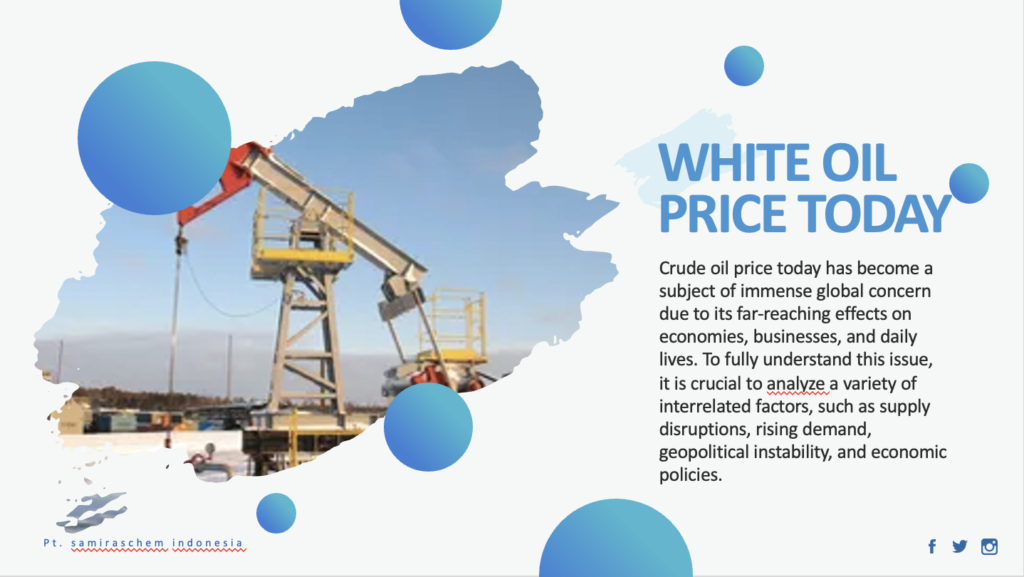Crude Oil Price Today : An In-Depth Analysis of White Oil Affect
Crude oil price today has become a subject of immense global concern due to its far-reaching effects on economies, businesses, and daily lives. To fully understand this issue, it is crucial to analyze a variety of interrelated factors, such as supply disruptions, rising demand, geopolitical instability, and economic policies. At present, crude oil prices have reached an extraordinary level of $2000 per unit, which reflects an extreme market scenario rather than standard trading conditions. Although this price may seem excessive, it is important to consider the reasons behind such a surge.
Primary Factors Affecting Crude Oil Price Today
To begin with, crude oil prices are primarily driven by supply and demand dynamics. For example, a reduction in supply often causes prices to skyrocket, especially when demand remains constant or increases. This imbalance can result from production cuts initiated by OPEC+, disruptions caused by wars, or natural disasters affecting oil fields. Moreover, logistical issues, such as delays in shipping routes or pipeline failures, further restrict the movement of oil to international markets.
At the same time, the demand for crude oil continues to grow. Developing nations experiencing rapid industrialization require large amounts of energy to sustain growth. In addition, transportation and manufacturing sectors, which rely heavily on crude oil, contribute significantly to rising demand. However, when demand surges while supply remains constrained, prices inevitably rise.
On the other hand, geopolitical tensions have also played a major role. For instance, sanctions imposed on oil-producing nations like Iran or Russia create substantial shortages in the market. As a result, oil-importing nations scramble to secure alternative supplies, often at higher costs. Consequently, such disruptions increase both volatility and price levels.
Crude Oil Density and Its Impact
Moving forward, it is essential to discuss crude oil density, as it significantly influences price and refining processes. Crude oil density is measured by its API gravity: lighter crudes, with an API gravity between 35–45 degrees, are more valuable because they produce higher yields of refined products like gasoline, diesel, and jet fuel. On the contrary, heavier crude oil, with a density exceeding 0.93 g/cm³, contains impurities and requires more complex refining techniques. Therefore, light crude commands a premium price, while heavier crude is less desirable.
For instance, in today’s market conditions, lighter crude oils are becoming increasingly scarce. As a result, refineries face significant challenges when processing heavier oils, leading to higher operational costs. These costs are eventually passed on to consumers.
Economic Implications of Surging Prices
Furthermore, the consequences of elevated crude oil prices extend far beyond the energy sector. For one, high oil prices directly impact transportation costs, causing inflation across the board. Additionally, businesses that rely heavily on transportation must increase the prices of goods and services to cover rising fuel expenses. Ultimately, this leads to higher living costs for consumers, particularly in energy-dependent nations.
To illustrate, consider oil-importing countries that face trade deficits when prices surge. As a result, local currencies often weaken against global benchmarks, such as the U.S. dollar. Meanwhile, governments are forced to allocate funds toward subsidies to shield consumers from price shocks. Nevertheless, these subsidies place strain on national budgets.
Conversely, oil-producing nations experience short-term economic benefits during price spikes. Increased revenues strengthen their economies, allowing for additional investments in infrastructure or development projects. However, overreliance on oil revenue carries risks, particularly if prices stabilize or decline unexpectedly. Thus, diversification remains essential for long-term sustainability.
The Role of Renewable Energy
Crude oil price today – On another note, the transition to renewable energy has gained momentum as crude oil prices remain volatile. Governments worldwide are pushing for investments in cleaner energy solutions, such as solar, wind, and electric power. However, renewable energy technologies have yet to replace crude oil’s dominance entirely. For example, despite advancements, large-scale adoption of electric vehicles or renewable power grids remains limited in many parts of the world. Consequently, crude oil continues to play an irreplaceable role in energy production.
Nevertheless, rising oil prices have accelerated efforts to shift toward sustainable alternatives. For instance, some nations are investing heavily in electric infrastructure to reduce reliance on fossil fuels. Furthermore, private sectors are embracing innovative technologies aimed at improving energy efficiency.
Conclusion – Crude Oil Price Today
In conclusion, the crude oil price today, which has surged to $2000 per unit under speculative scenarios, reflects a combination of supply disruptions, geopolitical tensions, rising demand, and market speculation. Moreover, crude oil density significantly determines its value, with lighter crude commanding higher prices due to its refining advantages.
As a result, industries, consumers, and governments are grappling with the economic challenges brought about by elevated prices. At the same time, efforts to transition toward renewable energy highlight the need for innovative solutions and international cooperation. Ultimately, achieving energy stability will require balancing crude oil dependence with investments in sustainable alternatives. By addressing these challenges proactively, nations can prepare for a future where energy security and economic stability coexist.
Key Statistics
- Price Today: $2000 per unit.
- Light Crude Density: 0.82–0.88 g/cm³.
- Heavy Crude Density: 0.93+ g/cm³.






